CPW-Fed Transparent Antenna for Vehicle Communications
Abstract
1. Introduction
2. Materials and Methods
3. Results and Discussion
4. Conclusions
Author Contributions
Funding
Acknowledgments
Conflicts of Interest
References
- Koga, Y.; Kai, M. A transparent double folded loop antenna for IoT applications. In Proceedings of the 2018 IEEE-APS Topical Conference on Antennas and Propagation in Wireless Communications (APWC), Cartagena des Indias, Colombia, 10–14 September 2018; pp. 762–765. [Google Scholar]
- Jain, B.; Brar, G.; Malhotra, J.; Rani, S. A novel approach for smart cities in convergence to wireless sensor networks. Sustain. Cities Soc. 2017, 35, 440–448. [Google Scholar] [CrossRef]
- Kirimtat, A.; Krejcar, O.; Kertesz, A.; Tasgetiren, M.F. Future trends and current state of smart city concepts: A survey. IEEE Access 2020, 8, 86448–86467. [Google Scholar] [CrossRef]
- Alavi, A.H.; Jiao, P.; Buttlar, W.G.; Lajnef, N. Internet of things-enabled smart cities: State-of-the-art and future trends. Measurement 2018, 129, 589–606. [Google Scholar] [CrossRef]
- Bibri, S.E.; Krogstie, J. Smart sustainable cities of the future: An extensive interdisciplinary literature review. Sustain. Cities Soc. 2017, 31, 183–212. [Google Scholar] [CrossRef]
- Wang, J.; Jiang, C.; Zhang, K.; Quek, T.Q.S.; Ren, Y.; Hanzo, L. Vehicular sensing networks in a smart city: Principles, technologies and applications. IEEE Wirel. Commun. 2018, 25, 122–132. [Google Scholar] [CrossRef]
- Matyakubov, M.; Rustamova, O. Development of smart city model: Smart bus system. In Proceedings of the 2019 International Conference on Information Science and Communications Technologies (ICISCT), Tashkent, Uzbekistan, 9–10 March 2019; pp. 1–5. [Google Scholar]
- Yang, L.; Mo, T.; Li, H. Research on V2V communication based on peer to peer network. In Proceedings of the 2018 International Conference on Intelligent Autonomous Systems (ICoIAS), Singapore, 1–3 March 2018; pp. 105–110. [Google Scholar]
- Alami, A.J.; El-Sayed, K.; Al-Horr, A.; Artail, H.; Guo, J. Improving the Car GPS accuracy using V2V and V2I communications. In Proceedings of the 2018 IEEE International Multidisciplinary Conference on Engineering Technology (IMCET), Beirut, Lebanon, 14–16 November 2018; pp. 1–6. [Google Scholar]
- Franzo, S.; Latilla, V.M.; Longo, M.; Bracco, S. Towards the new concept of smart roads: Regulatory framework and emerging projects overview. In Proceedings of the 2018 International Conference of Electrical and Electronic Technologies for Automotive, Milan, Italy, 9–11 July 2018; pp. 1–6. [Google Scholar]
- Jiang, D.; Delgrossi, L. Towards an international standard for wireless access in vehicular environments. In Proceedings of the VTC Spring 2008—IEEE Vehicular Technology Conference, Singapore, 11–14 May 2008; pp. 2036–2040. [Google Scholar]
- Roque-Cilia, S.; Tamariz-Flores, E.I.; Torrealba-Meléndez, R.; Covarrubias-Rosales, D.H. Transport tracking through communication in WDSN for smart cities. Measurement 2019, 139, 205–212. [Google Scholar] [CrossRef]
- IEEE Standard for Information Technology—Local and Metropolitan Area Networks—Specific Requirements—Part 11: Wireless LAN Medium Access Control (MAC) and Physical Layer (PHY) Specifications Amendment 6: Wireless Access in Vehicular Environments; IEEE: New York, NY, USA, 2010.
- Ucar, S.; Ergen, S.C.; Ozkasap, O. Multihop-cluster-based IEEE 802.11p and LTE hybrid architecture for VANET safety message dissemination. IEEE Trans. Veh. Technol. 2016, 65, 2621–2636. [Google Scholar] [CrossRef]
- Arena, F.; Pau, G.; Severino, A. A Review on IEEE 802.11p for intelligent transportation systems. J. Sens. Actuator Netw. 2020, 9, 22. [Google Scholar] [CrossRef]
- Choi, J.-Y.; Jo, H.-S.; Mun, C.; Yook, J.-G. Preamble-based adaptive channel estimation for IEEE 802.11p. Sensors 2019, 19, 2971. [Google Scholar] [CrossRef]
- Klapez, M.; Grazia, C.A.; Casoni, M. Minimization of IEEE 802.11p packet collision interference through transmission time shifting. J. Sens. Actuator Netw. 2020, 9, 17. [Google Scholar] [CrossRef]
- Xie, Y.; Ho, I.W.; Magsino, E.R. The modeling and cross-layer optimization of 802.11p VANET Unicast. IEEE Access 2018, 6, 171–186. [Google Scholar] [CrossRef]
- Syfullah, M.; Lim, J.M.-Y. Data broadcasting on Cloud-VANET for IEEE 802.11p and LTE hybrid VANET architectures. In Proceedings of the 3rd International Conference on Computational Intelligence & Communication Technology (CICT), Ghaziabad, India, 10–13 February 2017; pp. 1–6. [Google Scholar]
- Arora, A.; Mehra, A.; Mishra, K.K. Vehicle to vehicle (V2V) VANET based analysis on waiting time and performance in LTE network. In Proceedings of the 3rd International Conference on Trends in Electronics and Informatics (ICOEI), Tirunelveli, India, 23–25 April 2019; pp. 482–489. [Google Scholar]
- IEEE Standard for Definitions of Terms for Antennas; IEEE: New York, NY, USA, 1973.
- Duraj, D.; Rzymowski, M.; Nyka, K.; Kulas, L. ESPAR Antenna for V2X applications in 802.11p frequency band. In Proceedings of the 13th European Conference on Antennas and Propagation (EuCAP), Krakow, Poland, 31 March–5 April 2019; pp. 1–4. [Google Scholar]
- Condo Neira, E.; Carlsson, J.; Karlsson, K.; Ström, E.G. Combined LTE and IEEE 802.11p antenna for vehicular applications. In Proceedings of the 9th European Conference on Antennas and Propagation (EuCAP), Lisbon, Portugal, 12–17 April 2015; pp. 1–5. [Google Scholar]
- Madhav, B.; Anilkumar, T.; Kotamraju, K. Transparent and conformal wheel-shaped fractal antenna for vehicular communication applications. AEU Int. J. Electron. Commun. 2018, 91, 1–10. [Google Scholar] [CrossRef]
- Green, R.B.; Toporkov, M.; Ullah, M.D.B.; Avrutin, V.; Ozgur, U.; Morkoc, H.; Topsakal, E. An alternative material for transparent antennas for commercial and medical applications. Microw. Opt. Technol. Lett. 2017, 59, 773–777. [Google Scholar] [CrossRef]
- Lee, S.; Choo, M.; Jung, S.; Hong, W. Optically transparent nano-patterned antennas: A review and future directions. Appl. Sci. 2018, 8, 901. [Google Scholar] [CrossRef]
- Eltresy, N.A.; Elsheakh, D.N.; Abdallah, E.A.; Elhennawy, H.M. RF energy harvesting using transparent antenna for IoT application. In Proceedings of the 2019 International Conference on Innovative Trends in Computer Engineering (ITCE), Aswan, Egypt, 2–4 February 2019; pp. 287–291. [Google Scholar]
- Cai, L. An on-glass optically transparent monopole antenna with ultrawide bandwidth for solar energy harvesting. Electronics 2019, 8, 916. [Google Scholar] [CrossRef]
- Hakimi, S.; Rahim, S.K.A.; Abedian, M.; Noghabaei, S.M.; Khalily, M. CPW-fed transparent antenna for extended ultrawideband applications. IEEE Antennas Wirel. Propag. Lett. 2014, 13, 1251–1254. [Google Scholar] [CrossRef]
- Júnior, P.F.D.S.; Freire, R.C.S.; Serres, A.; Catunda, S.Y.; Silva, P.H.D.F. Bioinspired transparent antenna for WLAN application in 5 GHz. Microw. Opt. Technol. Lett. 2017, 59, 2879–2884. [Google Scholar] [CrossRef]
- Hong, S.; Kang, S.H.; Kim, Y.; Jung, C.W. Transparent and flexible antenna for wearable glasses applications. IEEE Trans. Antennas Propag. 2016, 64, 2797–2804. [Google Scholar] [CrossRef]
- Hautcoeur, J.; Colombel, F.; Castel, X.; Himdi, M.; Cruz, E.M. Radiofrequency performances of transparent ultra-wideband antennas. Prog. Electromagn. Res. C 2011, 22, 259–271. [Google Scholar] [CrossRef]
- Martin, A.; Castel, X.; Lafond, O.; Himdi, M. Optically transparent frequency-agile antenna for X-band applications. Electron. Lett. 2015, 51, 1231–1233. [Google Scholar] [CrossRef]
- Martin, A.; Castel, X.; Himdi, M.; Lafond, O. Mesh parameters influence on transparent and active antennas performance at microwaves. AIP Adv. 2017, 7, 085120. [Google Scholar] [CrossRef]
- Martin, A.; Lafond, O.; Himdi, M.; Castel, X. Improvement of 60 GHz transparent patch antenna array performance through specific double-sided micrometric mesh metal technology. IEEE Access 2019, 7, 2256–2262. [Google Scholar] [CrossRef]
- Desai, A.; Upadhyaya, T.; Patel, J.; Patel, R.; Palandoken, M. Flexible CPW fed transparent antenna for WLAN and sub-6 GHz 5G applications. Microw. Opt. Technol. Lett. 2020, 62, 2090–2103. [Google Scholar] [CrossRef]
- Desai, A.; Upadhyaya, T.; Palandoken, M.; Patel, J.; Patel, R. Transparent conductive oxide-based multiband CPW fed antenna. Wirel. Pers. Commun. 2020, 113, 961–975. [Google Scholar] [CrossRef]
- Kashanianfard, M.; Sarabandi, K. Vehicular optically transparent UHF antenna for terrestrial communication. IEEE Trans. Antennas Propag. 2017, 65, 3942–3949. [Google Scholar] [CrossRef]
- Lee, J.; Lee, H.; Kim, D.; Jung, W. Transparent dual-band monopole antenna using a μ-metal mesh on the rear glass of an automobile for frequency modulation/digital media broadcasting service receiving. Microw. Opt. Technol. Lett. 2019, 61, 503–508. [Google Scholar] [CrossRef]
- Liu, T.-W.; Tu, W.-H. CPW-fed tri-band slot antenna with impedance matching stub. In Proceedings of the 2016 IEEE/ACES International Conference on Wireless Information Technology and Systems (ICWITS) and Applied Computational Electromagnetics (ACES), Honolulu, HI, USA, 13–17 March 2016; pp. 1–2. [Google Scholar]
- Chen, S.-Y.; Chen, Y.-C.; Hsu, P. CPW-fed aperture-coupled slot dipole antenna for tri-band operation. IEEE Antennas Wirel. Propag. Lett. 2008, 7, 535–537. [Google Scholar] [CrossRef]
- Smits, F.M. Measurement of sheet resistivities with the four-point probe. Bell Syst. Tech. J. 1958, 37, 711–718. [Google Scholar] [CrossRef]
- Haraty, M.R.; Naser-Moghadasi, M.; Lotfi-Neyestanak, A.A.; Nikfarjam, A. Improving the efficiency of transparent antenna using gold nano Layer deposition. IEEE Antennas Wirel. Propag. Lett. 2015, 4–7. [Google Scholar] [CrossRef]

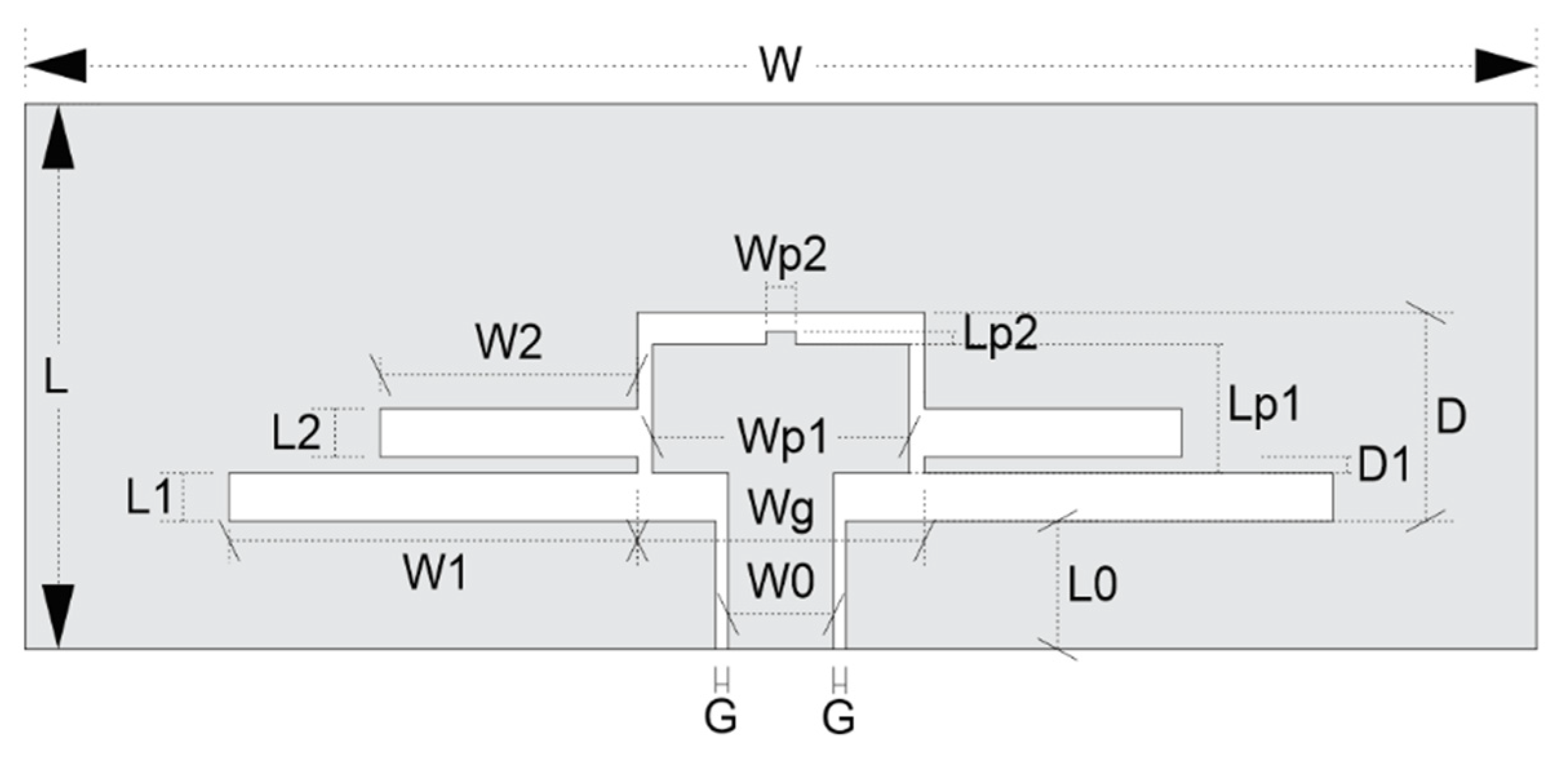
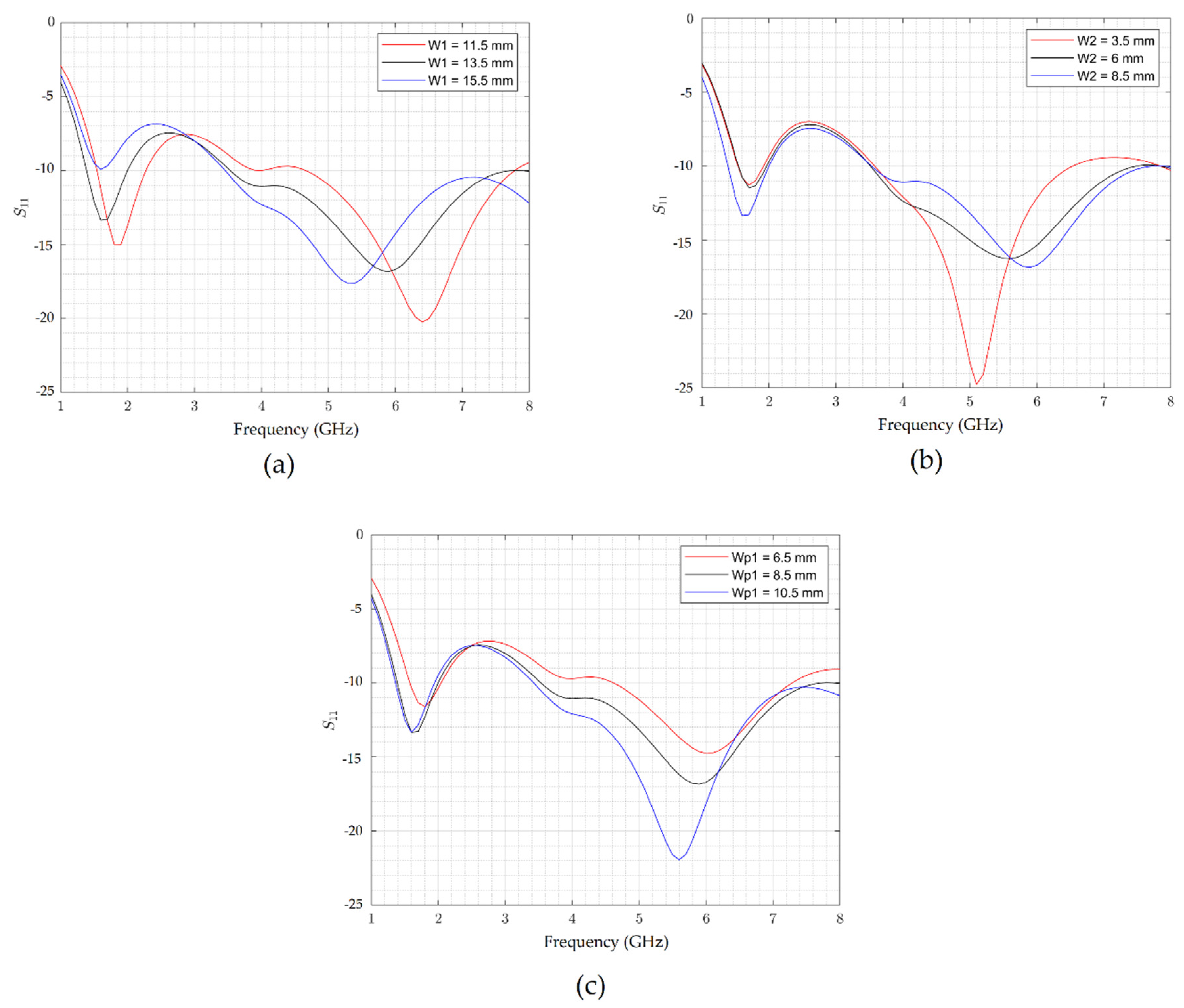

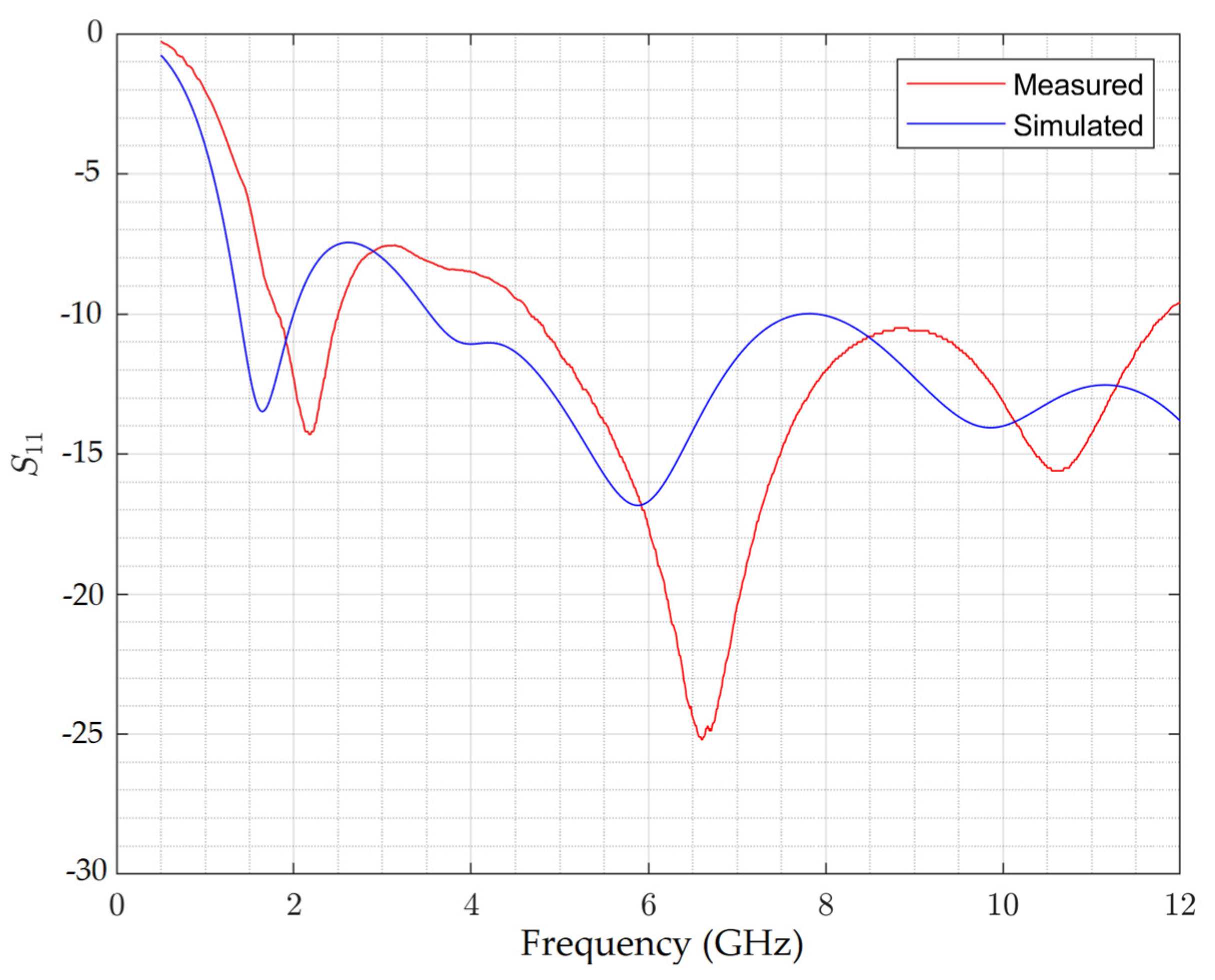
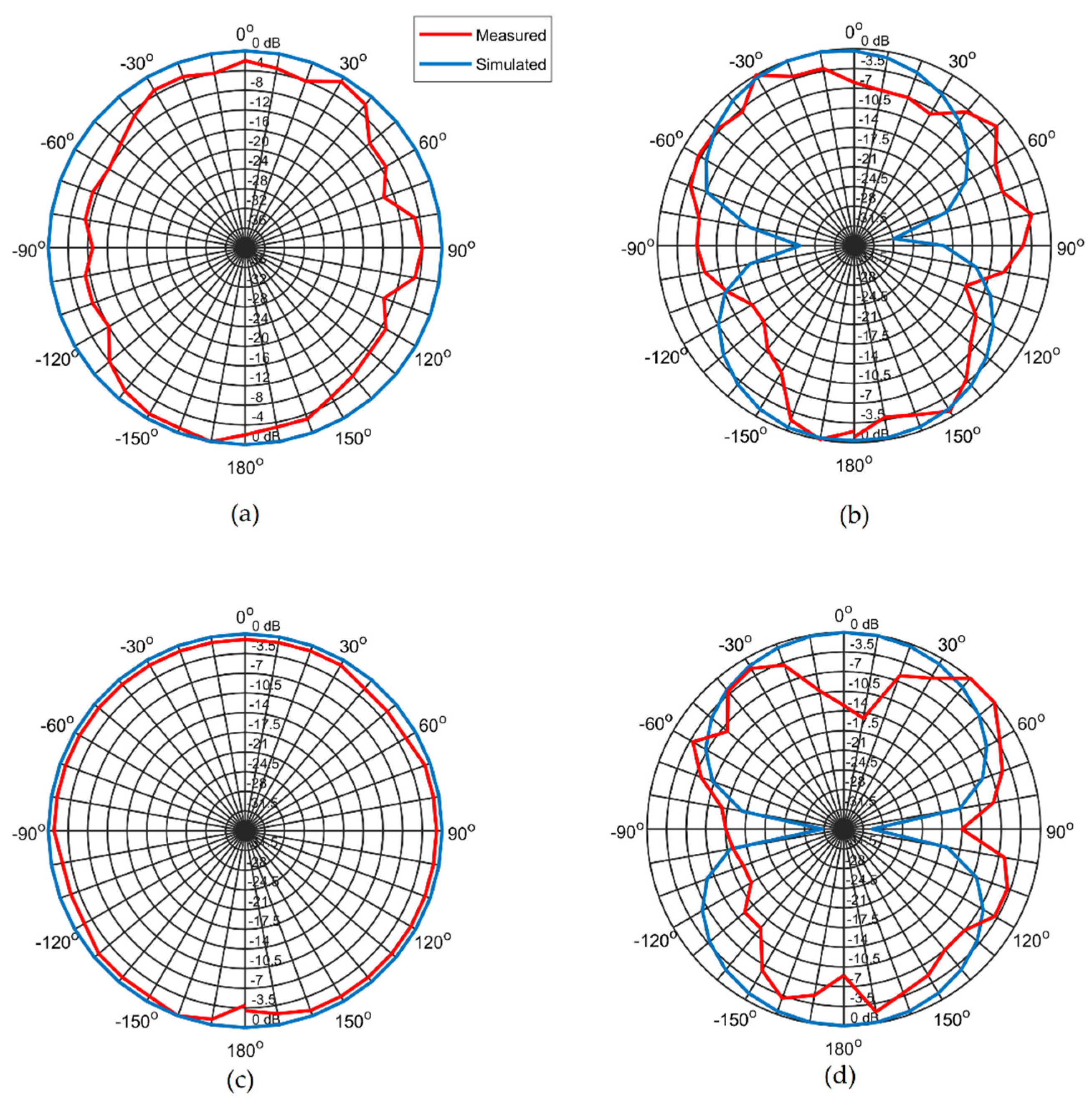
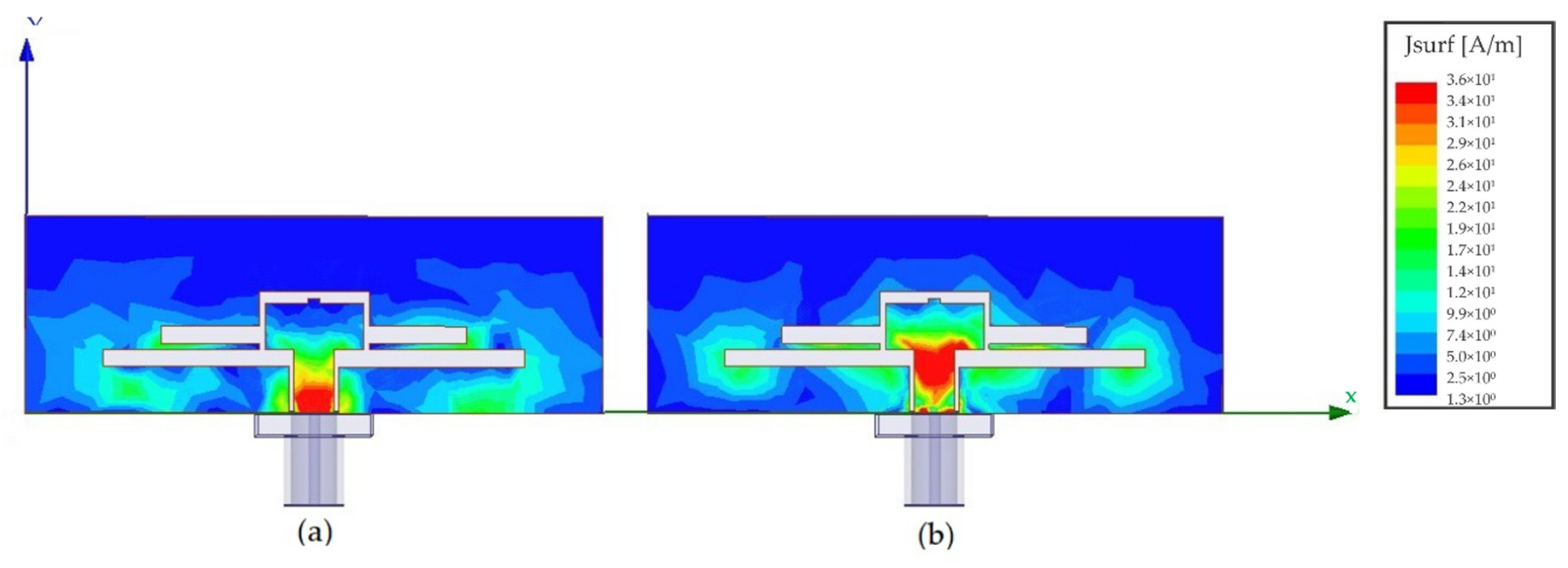
| Position | Resistance (Ω) |
|---|---|
| 1 | 7.831 |
| 2 | 7.909 |
| 3 | 7.970 |
| 4 | 8.008 |
| 5 | 8.035 |
| 6 | 7.997 |
| 7 | 7.914 |
| 8 | 7.954 |
| 9 | 7.914 |
| 10 | 7.900 |
| 11 | 7.922 |
| 12 | 7.958 |
| 13 | 7.950 |
| Average | 7.943 |
| Parameter | Size (mm) | Parameter | Size (mm) |
|---|---|---|---|
| W | 50 | L | 17 |
| Wg | 9.5 | Lp1 | 4 |
| Wp1 | 8.5 | Lp2 | 0.4 |
| Wp2 | 1 | L0 | 4 |
| W0 | 3.5 | L1 | 1.5 |
| W1 | 13.5 | L2 | 1.5 |
| W2 | 8.5 | D | 6.5 |
| G | 0.4 | D1 | 0.5 |
| frange | FBW | |
|---|---|---|
| S | 1.39–1.99 | 36.36% |
| M | 1.82–2.5 | 31.34% |
| S | 3.54–7.75 | 71.35% |
| M | 4.66–11.84 | 87.03% |
| 2.1 GHz | 5.9 GHz | |
|---|---|---|
| S | −0.167 dB | −2.12 dB |
| M | −0.145 dB | −3.9 dB |
| Reference. | Frequencies (GHz) | S11 Min Level (dB) | Substrate//Conductive Film | Dimensions (mm) | Match between M and S of S11 * |
|---|---|---|---|---|---|
| [25] | 2.19–2.58 | −13.97 | Sapphire//GZO | 60 × 10 × 0.375 | No |
| [29] | 2–6 | −25 | Glass//ITO | 25 × 25 × 1.1 | No |
| [30] | 1–7 | <−15 | Glass//ITO | 50 × 50 × 1.1 | No reported |
| [32] | 4.5–7 | −25 | Acetate//ITO | 50 × 51 × 0.28 | No |
| [33] | 2.4–2.65 | −15 | C58//IZTO/Ag/IZTO | 23.4 × 2 | Yes |
| [38] | 3.89–5.97 | −24 | PET//AgHT-8 | 58 × 78 × 0.9 | Yes |
| This work | 1.8–2.5/4.66–11.84 | −25 | Glass//ITO | 50 × 17 × 1.1 | Yes |
© 2020 by the authors. Licensee MDPI, Basel, Switzerland. This article is an open access article distributed under the terms and conditions of the Creative Commons Attribution (CC BY) license (http://creativecommons.org/licenses/by/4.0/).
Share and Cite
Trujillo-Flores, J.I.; Torrealba-Meléndez, R.; Muñoz-Pacheco, J.M.; Vásquez-Agustín, M.A.; Tamariz-Flores, E.I.; Colín-Beltrán, E.; López-López, M. CPW-Fed Transparent Antenna for Vehicle Communications. Appl. Sci. 2020, 10, 6001. https://doi.org/10.3390/app10176001
Trujillo-Flores JI, Torrealba-Meléndez R, Muñoz-Pacheco JM, Vásquez-Agustín MA, Tamariz-Flores EI, Colín-Beltrán E, López-López M. CPW-Fed Transparent Antenna for Vehicle Communications. Applied Sciences. 2020; 10(17):6001. https://doi.org/10.3390/app10176001
Chicago/Turabian StyleTrujillo-Flores, Jorge Iván, Richard Torrealba-Meléndez, Jesús Manuel Muñoz-Pacheco, Marco Antonio Vásquez-Agustín, Edna Iliana Tamariz-Flores, Edgar Colín-Beltrán, and Mario López-López. 2020. "CPW-Fed Transparent Antenna for Vehicle Communications" Applied Sciences 10, no. 17: 6001. https://doi.org/10.3390/app10176001
APA StyleTrujillo-Flores, J. I., Torrealba-Meléndez, R., Muñoz-Pacheco, J. M., Vásquez-Agustín, M. A., Tamariz-Flores, E. I., Colín-Beltrán, E., & López-López, M. (2020). CPW-Fed Transparent Antenna for Vehicle Communications. Applied Sciences, 10(17), 6001. https://doi.org/10.3390/app10176001







